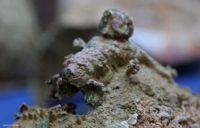 A team of divers have made a unique discovery on the seabed off the coast of Sicily: a Punic War-era helmet with a lion decoration. It is a Montefortino helmet, a Celtic style that was spread from central Europe down the boot of Italy to Western Europe. They typically are a half ovoid shape with a small knob at the crest and cheek flaps tied under the chin by leather straps. Rome adopted the helmet style and then forcibly adopted much of the world while wearing them, so they also became known as “Roman helmets.” The lion, or possibly a lion skin posed in an aggressive stance, decorates the crest knob. This is the first lion decoration ever found on this type of helmet. The only example even vaguely in the same category had some kind of bird decoration, but it was very stylized and can’t be pinned down. The lion, on the other hand, is clearly a lion.
A team of divers have made a unique discovery on the seabed off the coast of Sicily: a Punic War-era helmet with a lion decoration. It is a Montefortino helmet, a Celtic style that was spread from central Europe down the boot of Italy to Western Europe. They typically are a half ovoid shape with a small knob at the crest and cheek flaps tied under the chin by leather straps. Rome adopted the helmet style and then forcibly adopted much of the world while wearing them, so they also became known as “Roman helmets.” The lion, or possibly a lion skin posed in an aggressive stance, decorates the crest knob. This is the first lion decoration ever found on this type of helmet. The only example even vaguely in the same category had some kind of bird decoration, but it was very stylized and can’t be pinned down. The lion, on the other hand, is clearly a lion.
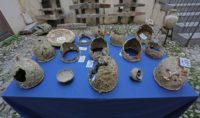 Marine archaeologists have dated the helmet to 241 B.C., based on some of the pottery remains at the find site, the style of the armour and the date of a battle which has proven an incalculably rich source of archaeological material from the First Punic War. Egadi, an island in the Aegadian archipelago about 4 miles off the west coast of Sicily. It was the site of one of the last naval clashes of the First Punic War. In 241 B.C., 200 Roman ships went up against 100 Carthaginian ships in the Battle of the Egadi Islands. Well, actually, the Roman ships appear to have gone up against other Roman ships, mainly, captured by Carthage in previous naval battles such as the Battle of Drepanum (249 B.C.) in which Polybius claimed 97 ships had been taken and absorbed into the Punic navy. Rome’s superior numbers took the day this time, and Carthage was soundly spanked. So soundly, in fact, that they surrendered shortly thereafter ending the First Punic War.
Marine archaeologists have dated the helmet to 241 B.C., based on some of the pottery remains at the find site, the style of the armour and the date of a battle which has proven an incalculably rich source of archaeological material from the First Punic War. Egadi, an island in the Aegadian archipelago about 4 miles off the west coast of Sicily. It was the site of one of the last naval clashes of the First Punic War. In 241 B.C., 200 Roman ships went up against 100 Carthaginian ships in the Battle of the Egadi Islands. Well, actually, the Roman ships appear to have gone up against other Roman ships, mainly, captured by Carthage in previous naval battles such as the Battle of Drepanum (249 B.C.) in which Polybius claimed 97 ships had been taken and absorbed into the Punic navy. Rome’s superior numbers took the day this time, and Carthage was soundly spanked. So soundly, in fact, that they surrendered shortly thereafter ending the First Punic War.
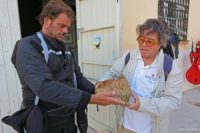 The net effect of Carthage’s deployment of Roman vessels is that even though Rome won the Battle of the Egadi Islands most emphatically, the ship parts, cargo and weapons strewn on the seafloor are predominantly Roman. The lion helmet could be as well, but that can’t be confirmed because of how widespread the Montefortino helmet was at the time of the First Punic War.
The net effect of Carthage’s deployment of Roman vessels is that even though Rome won the Battle of the Egadi Islands most emphatically, the ship parts, cargo and weapons strewn on the seafloor are predominantly Roman. The lion helmet could be as well, but that can’t be confirmed because of how widespread the Montefortino helmet was at the time of the First Punic War.
Possibly the lion-theme decoration can be traced back to a city allied with Rome where the influence of the myth of Hercules – who was often represented wearing lion skin on his head – was strong.
It is also possible that the lion insignia indicated a rank of authority within the Roman army at this time. “The helmets could have been worn by any number of mercenaries of South Italian or Sicilian origin. The problem is, both sides were hiring in the same areas,” Royal told Haaretz. “The Romans also wore a version of this style. Hence, some helmets were likely worn by mercenaries in service of the Carthaginians, but some may also represent Roman soldiers lost in the battle.”
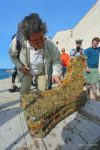 Also representing shipfuls of dead Roman soldiers is the large number of bronze battering rams (rostra) which are still rare finds, but have increased geometrically thanks to Egadi’s extraordinary pile of Roman battle detritus. Out of the 13 battering rams found so far at Egadi over the past decade, only two of them have inscriptions identifying them as Carthaginian. The others have inscriptions too, but all of them in Latin.
Also representing shipfuls of dead Roman soldiers is the large number of bronze battering rams (rostra) which are still rare finds, but have increased geometrically thanks to Egadi’s extraordinary pile of Roman battle detritus. Out of the 13 battering rams found so far at Egadi over the past decade, only two of them have inscriptions identifying them as Carthaginian. The others have inscriptions too, but all of them in Latin.
The vicious, spiky-looking bronze battering rams are of great historical significance because of their badassness and rarity, yes, but finding so many in one place connected to a single battle has provided scholars with a unique opportunity to study the ships they used to 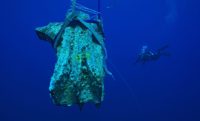 be attached to, now long since rotted away in the balmy Mediterranean waters. The rams were fixed to the prow of ships, custom cast to ensure a perfect fit along the bows. Researchers can calculate the dimensions of the keels based on the size and shape of the rostra.
be attached to, now long since rotted away in the balmy Mediterranean waters. The rams were fixed to the prow of ships, custom cast to ensure a perfect fit along the bows. Researchers can calculate the dimensions of the keels based on the size and shape of the rostra.
Based on those measurements, the researchers believe the ships were triremes, the principal type of warship in the Roman-era Mediterranean, which boasted three decks of oarsmen.
The archaeologists calculate that the ships could not have been more than 30 meters long and just 4.5 meter in beam, far less than the 36 meters previously estimated for the Athenian trireme. […]
In battle, the trireme was propelled solely by its 170 rowers. These wooden ships are believed to have been able to achieve a speed of 10 knots at the critical moment of impact.
Rams mounted below the waterline had three horizontal planes that would slice into their targets’ timbers, cracking the enemy ship. The dispersal of amphorae and other goods on the seabed indicates that ships were indeed sunk, but did not break up.
The lion helmet, the other helmets and battering rams recovered this season are currently being cleaned and conserved. Archaeologists to learn more about the one-of-a-kind lion helmet and to expand our understanding of Rome’s naval capabilities by studying the finds.
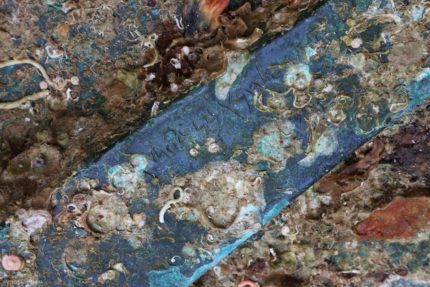
That ‘Punic War’ inscription is seemingly read from right to left, and unfortunately they mainly used consonants, but it might be something like “… ol(h)etarntlom“, or something completely different.
Presumably, it is all about ‘boat crushing power’, ‘power’ and ‘boat crushing’. The Standard Phoenician inscription of Tabnit of Sidon, to give an example, from the 5th century BC contains: 𐤀𐤔𐤌𐤍𐤏𐤆𐤓 𐤊𐤇𐤍 𐤏𐤔𐤕𐤓𐤕 𐤌𐤋𐤊 𐤑𐤃𐤍𐤌 𐤔𐤊𐤁 𐤁𐤀𐤓𐤍 𐤆 which stands for “ʾšmnʿzr khn ʿštrt mlk ṣdnm škb bʾrn z”.
With reference to the ‘Cimbrian War’, there is the ‘Negau’ helm type depot (from what is now Slovenia) with 26 bronze helmets, and some feature Germanic or Raetic inscritions (cf. Battle of Noreia).
The link between Phoenician and this (Negau) would be Greek script, cf.: 𐌇𐌀𐌓𐌉𐌊𐌀𐌔𐌕𐌉𐌕𐌄𐌉𐌅𐌀///𐌉𐌐 (‘Harigast’) or harikastiteiva\\\ip, and -of course- Etruscan.
How can the helmet be dated so precisely, surely it is ‘no later than 241 B.C.’, the date of its loss?
The 1st Punic War -as its last battles did- simply ended in 241BC. A pity that there is no surviving wood.
That thing in the 2nd picture, i.e. on that table in the background on the left, seems to be what is referred to as a mortar(ium), either used for cooking purposes -or- for grinding processes that were used in ancient warfare.
Of course, provided there was anything to grind for that early – a Ὑγρὸν Πῦρ (flamethrower) maybe, e.g. in combination with pumps that Ctesibius (Κτησίβιος ὁ Ἀλεξανδρεύς, 285–222 BC) described in Northern Africa.
Those mortaria, it seems, were indeed used for grain, as Polybius (Histories, Bk 1, 60/61) describes the battle as follows:
——————————
“When the unexpected news reached Carthage that the Romans were at sea with a fleet and were again disputing the naval supremacy, they at once got their ships ready, and filling them with grain and other provisions, dispatched their fleet on its errand, desiring that the troops at Eryx [modern Erice on Sicily] should be in no need of necessary supplies. Hanno, whom they appointed to command the naval force, set sail and reached the so-called Holy Isle [Marettimo island] from whence he designed to cross as soon as possible to Eryx, unobserved by the enemy, and, after lightening the ships by disembarking the supplies, to take on board as marines the best qualified mercenaries together with Barcas himself and then engage the enemy. Lutatius, learning of Hanno’s arrival and divining his intentions, took on board a picked force from the army and sailed to the island of Aegusa [island of Favignana] which lies off Lilybaeum [modern Marsala]. There, after exhorting his troops as became the occasion, he informed the captains that the battle would take place next day. […]”
“[…] As for the Roman Consul, he sailed away to Lilybaeum and the legions, and there occupied himself with the disposal of the captured ships and men, a business of some magnitude, as the prisoners made in the battle numbered very nearly ten thousand.”
——————————
A minor nit pick: “Battering” is probably redundant or inappropriate when referring to naval rams or rostra. A battering ram is more properly used to refer to the baulk of wood used to batter down the gate or door of a fortification or castle. Batter is a verb implying multiple blows.
The term rostrum as a place for a speaker comes from the Roman custom of the victorious commander ascending to the top of captured rams to address the troops, citizens, or others.
Yes, ‘battering’ does seem inappropriate, they look more like multi-blade cutting instruments.
With their flat front I would guess the art was not just in managing to hit the opponents ship, but to do so at a slight angle so the the force was concentrated at the corner of the ram, so the blades could slice into the hull, but not too much of an angle that one slid along the hull instead.
My own non-native speaker’s English is a rather ‘battered’ one, and presumably ‘battering’ is something that you do repeatedly.
Contrastingly, the intention to use it here, was probably to express the sheer force behind a ram/ rostrum of several hundred accelerated kilograms. Whatever you might call it, the idea was always to make a hole and sink the rammed ship, i.e. without her crew boarding the ramming vessel.
Caesar himself, in his ‘Commentaries on the Gallic War’, 3.13 [from 3.13.1 onwards, he describes the ships of the Venetii, here 3.13.7-8] puts it as follows:
—————–
“The encounter of our fleet with these ships’ was of such a nature that our fleet excelled only in speed and the plying of the oars; considering the nature of the place and the violence of the storms, however, theirs were more suitable and better adapted; for neither could our ships injure theirs with our beaks (so great was their strength), nor on account of their height was a weapon easily cast up to them; and for the same reason they were less readily locked in by rocks.”
[7] Cum his navibus nostrae classi eius modi congressus erat ut una celeritate et pulsu remorum praestaret, reliqua pro loci natura, pro vi tempestatum illis essent aptiora et accommodatiora. [8] Neque enim iis nostrae rostro nocere poterant (tanta in iis erat firmitudo), neque propter altitudinem facile telum adigebatur, et eadem de causa minus commode copulis continebantur.
—————–
Thus, the “trick”, simply to enhance the acceleration that, according to Polybios, the Romans confronted the Punii with in the 1st Punic War, seemingly did not work any longer against the Venetii.
Which ‘other’ and ‘better’ tricks he applied, or claims to have applied, is described in his Book. Whatever he did, it seems to have worked.